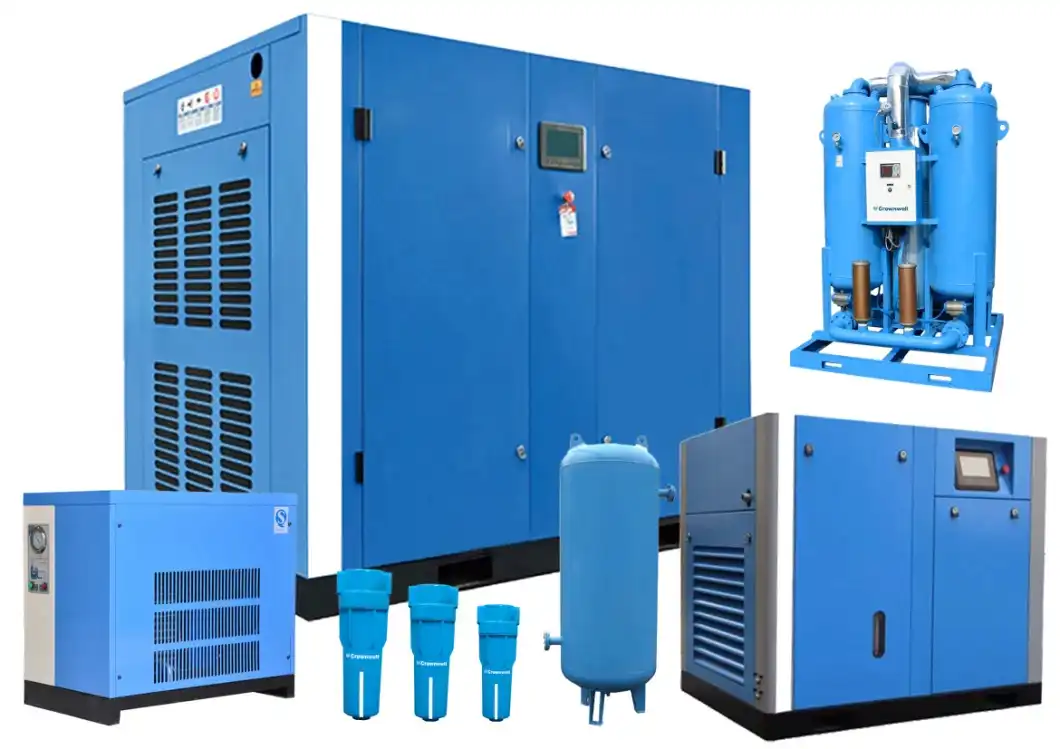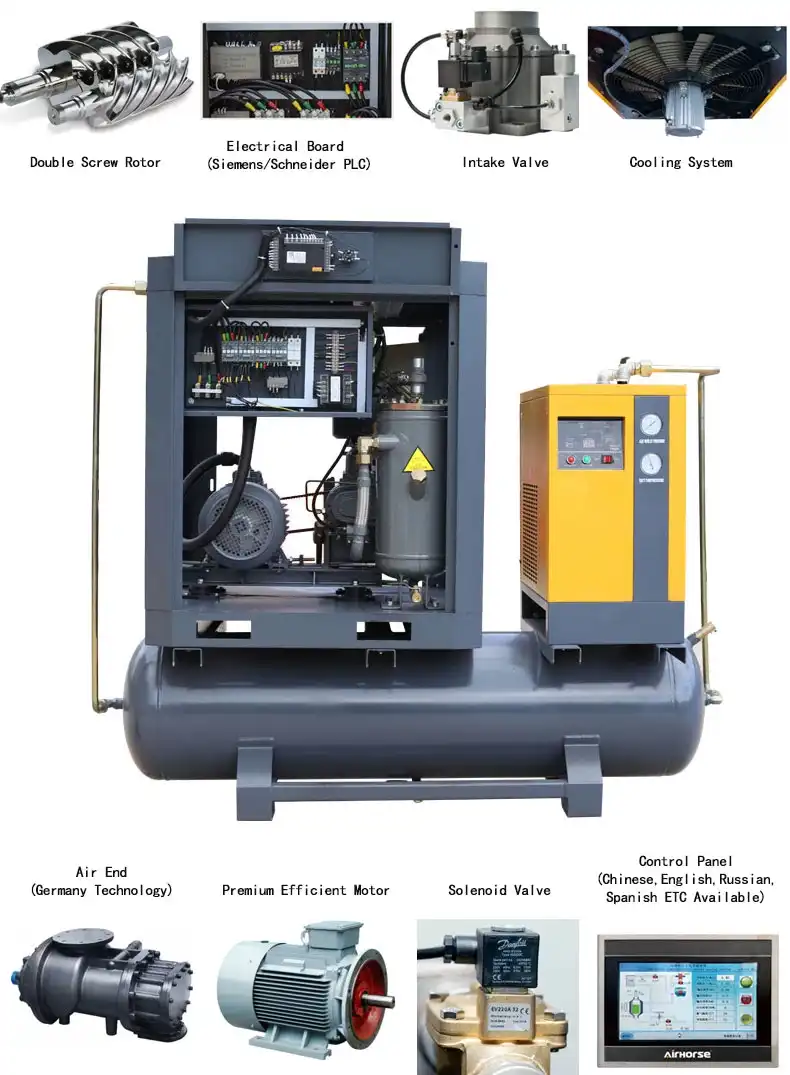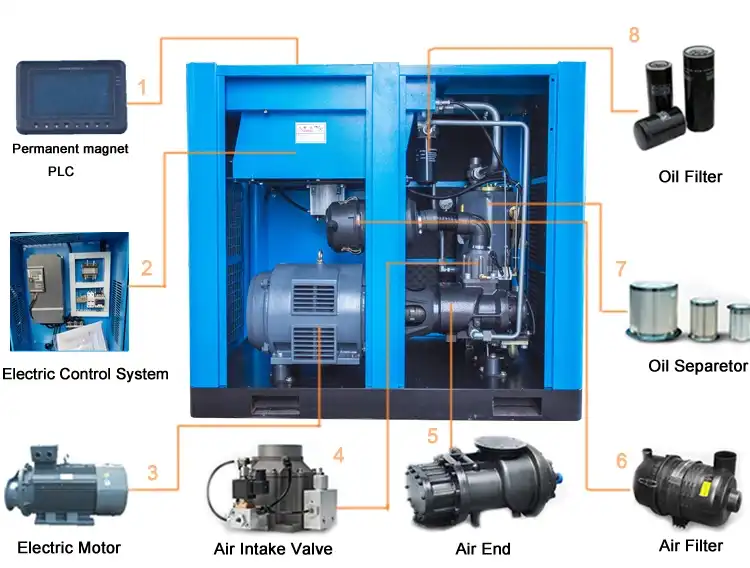Item Description
Rapid Specifics
| Applicable Industries:
Building Material Shops, Manufacturing Plant, Machinery Repair Shops, Food & Beverage Factory, Construction works , Energy & Mining, Other
|
Customized support:
OEM, ODM
|
| Part name :SPA SPB cast iron pilot bore 3 grooves timing belt pulley | Surface treatment: Blackened/blue |
| Material: C45 | Brand Name:REACHJY |
| Application:power transmission | Inspection: 100% |
| Certification:ISO | Place of Origin:Sichuan, China |
| Applicable Industries:
Building Material Shops, Manufacturing Plant, Machinery Repair Shops, Food & Beverage Factory, Construction works , Energy & Mining, Other
|
Customized support:
OEM, ODM
|
| Part name :SPA SPB cast iron pilot bore 3 grooves timing belt pulley | Surface treatment: Blackened/blue |
| Material: C45 | Brand Name:REACHJY |
| Application:power transmission | Inspection: 100% |
| Certification:ISO | Place of Origin:Sichuan, China |
How to Repair and Maintain an Air Compressor
A compressor is a device used to move air from one place to another. Air enters the air compressor through the intake valve. Inside the compressor, the vanes on the inner rotor rotate within an eccentric cavity. The self-adjusting length arm divides the space into multiple cavities of different sizes. As the rotor rotates, air fills the cavity. As air flows around the cavity, it builds pressure and is squeezed out of the compressor output.
Positive displacement
Positive displacement air compressors use reciprocating pistons to compress air. Gas is drawn in during the suction stroke and compressed by moving the piston in the opposite direction. It then discharges the compressed air by moving it in the opposite direction. This type of air compressor is most commonly found in automobiles, refrigerators, and other applications that require high pressure. However, it is not as efficient as a centrifugal compressor.
Most modern air compressors use positive displacement. Positive displacement models capture a volume of air in the compression chamber and distribute it when the pump is operating at maximum capacity. They are more economical than their negative displacement counterparts. Reciprocating screw air compressors are the most common positive displacement compressors. The reciprocating screw air compressor adopts a water jacket around the cylinder and is often used in processes such as oil drilling.
A bicycle pump is an example of positive displacement compression. Air is drawn into the cylinder and compressed by the moving piston. A piston compressor works on the same principle, but it uses a rotating crankshaft or connecting rod to complete the movement of the pistons. There are two types of positive displacement compressors: single-acting and double-acting. Both types work on the same principle, both are positive displacement compressors. The difference between the two types is the pressure ratio.
In air compression, positive displacement compression reduces the volume of the fluid and reduces its viscosity. This results in higher pressure ratios and is used in centrifugal, axial, and scroll compressors. Positive displacement is a common feature of most air compressors. Positive displacement compressors offer the same benefits and are more energy-efficient when applied to oil-free and gas applications. This type of compression is usually the best choice for low-pressure applications.
oil free
If you're looking for an air compressor for your business, consider an oil-free air compressor. These models offer cleaner, quieter operation than traditional air compressors and require less maintenance. They also meet ISO Class 0 or Class 1 air purity requirements. Oil-free air compressors are also quieter, with fewer moving parts and less noise. These advantages make oil-free air compressors an ideal solution for many commercial applications.
Air purity is critical in many industries. Even the tiniest drop of oil can damage production equipment or damage products. The best way to find an oil-free air compressor for your business is to consider the process and end product. As air quality improves, more and more businesses are turning to oil-free compressors. Some of the advantages and disadvantages of these air compressors are:
When choosing an oil-free air compressor, it is important to understand the terminology used in the industry. Knowing these terms will make it easier for you to choose the right compressor for your needs. ACTFM, or actual cubic feet per minute, is an industry term for measuring the amount of air pumped in one minute under rated conditions. Although a simple number, it can be very useful in determining which type of air compressor is best for your application.
The ISO 8573-1 international standard defines air quality and provides air purity classifications. The strictest classification is air purity class 0. Many manufacturers claim that oil-free air compressors meet this standard. However, a class 0 oil-free air compressor does not necessarily mean that the air is free of contaminants. In fact, Class 0 is the benchmark for air purity. While zero air quality is the highest level, that doesn't mean it's completely oil-free.
double acting
A double-acting air compressor is a device that uses compressed air to generate electricity. Its working principle is based on piston and connecting rod. The connecting rod connects the crankshaft to the piston through pins and caps. The piston moves as the piston moves. Rods are usually made of forged carbon steel. In terms of service and maintenance, double-acting compressors require regular vise maintenance and proper cleaning.
The displacement of the compressor is a measure of the displacement that the piston can produce in a certain period of time. Displacement is usually expressed in actual cubic feet per minute. The exact calculation depends on the type of cylinder and the configuration of the compressor. Single-acting cylinders can have head-end or crank-end displacement, both of which can be measured using the displacement equation. A double-acting air compressor will use this equation. 4 and 6 calculate the displacement.
Double-acting air compressors have multiple cylinders and are made of cast iron. They are water-cooled and have a mechanical connection between the piston and connecting rod. A double-acting compressor compresses air twice per revolution of the motor. One cylinder moves up, while the other cylinder moves down. The piston moves down, allowing air to enter through valve #1. During the operation of the compressor, the temperature of the air and gas increases.
Double-acting air compressors typically have high pressure and are considered workhorses. Double-acting compressors also feature intercooling and double compression. As a result, these machines tend to last longer than single-acting compressors. Its low speed and dual compression make it a workhorse in the compressor industry. Double-acting air compressors are workhorses and versatile devices.
fuel tank pressure switch
You can adjust the pressure in the air compressor tank by adjusting the differential pressure. You can turn the mainspring clockwise or counterclockwise to increase or decrease the pressure. This valve will open when the pressure is low enough to start the compressor. If the pressure is too low, the valve should be closed. The cut-in and cut-out pressures should be set to appropriate values. After adjusting the tank pressure, check the hysteresis of the tank pressure switch and set the desired shutoff pressure.
If the pressure in the tank falls below the cut-in level, the tank pressure switch must be replaced. You can test the switch with a multimeter. Make sure the switch is not damaged. If you can't find the switch, you can look at the other sections. If you find any damaged or missing parts, you should replace them. Otherwise, it may be time to check the tank pressure switch. You may need to disassemble the compressor and remove the switch.
The fuel tank pressure switch is an important part of the air compressor. It keeps you informed of the amount of air delivered by the compressor. If your tank or tank is damaged, your readings will be wrong. If the pressure switch is damaged, it will not function properly and result in incorrect readings. Fortunately, there are some easy ways to fix this. To prevent this from happening, keep the tank pressure switch in good condition.
When the air pressure in the tank drops to the cut-in pressure setting, the switch allows power to flow through it. This will start the motor and pump of the air compressor. Then, if the pressure in the tank rises above the cut-off level, the switch will trip and stop the compressor. This will prevent it from being over-pressurized. Power flow will continue to flow to the motor. Depending on your compressor model, you can change the cut-in and cut-out pressures as needed.
energy source
The power supply of the air compressor is very important. Most air compressors run on 12 VDC, which is ideal for automotive use. Alternatively, you can buy a switching power supply for around $20. No matter which power supply you choose, you must ensure that it can support the maximum current of the compressor. You can find power supplies in all sizes, from quarter-horsepower to five-horsepower.
The voltage required for a three-phase air compressor will vary. Three-phase air compressors require three separate power cords and a three-phase electrical service panel. This is because a standard 120/240-volt electrical service panel is not sufficient to power a three-phase compressor. Additionally, three-phase compressors require three separate isolated wires for the engine and motor circuits. Three-phase compressors do not require a neutral wire.

